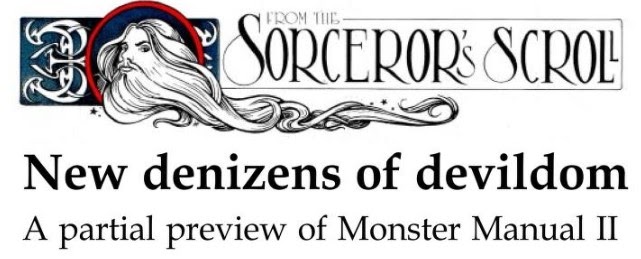SMOOSH JUICE
The Articles of Dragon: “New Denizens of Devildom”

I’m sure it’ll come as no surprise that issue #75 of Dragon (July 1983) is among my favorites, one I both remember very well (and for which I, therefore, have a great deal of nostalgia) and one whose content was of very high quality. Indeed, I’d go so far as to say that the run of issues between, say, issue #65 (September 1982) and issue #100 (August 1985) may well have been the magazine’s best ever. I’m biased, of course, since this run not coincidentally coincides with when I subscribed to Dragon, but I really do think that, from a reasonably objective perspective, that three-year period was exceptional, filled with some of the most interesting and inspiring articles ever to grace Dragon‘s pages.
Issue #75 is probably best remembered for the first part of Ed Greenwood’s superb treatment of the Nine Hells and rightly so. What people sometimes forget is that the issue also included a partial preview of the upcoming Monster Manual II in Gary Gygax’s regular “From the Sorcerer’s Scroll” column. In fact, I believe it was precisely because of the planned appearance of this preview that Greenwood was given the go-ahead – with Gygax’s blessing – to develop the Nine Hells as an adventuring locale suitable for use with AD&D.
Over the course of six pages, Gygax provides game statistics for a plethora of new devils, both generic and specific. The generic ones are notable, in that they run the gamut of hit dice, from the 3 HD spined devils to 8 HD black abishai. While AD&D had always included weaker devils and demons as opponents, I know that, as a younger person, I appreciated the addition of more at the lower end of the diabolic spectrum. Devils, as envisaged by Gygax, have always been compelling enemies to me, but they were mostly the enemies for higher-level characters, given their hit dice and powers. By including more options at the low end, Gygax made it easier for me to use them with a wider range of character levels.
Of course, the true stars of this article (and the Monster Manual II) were the specific, named devils, including several new arch-devils. This pleased me greatly back in the day. The original Monster Manual was the very first AD&D book I ever owned. I bought it at a Sears catalog store in early 1980, using money I’d got for Christmas and I spent an inordinate amount of time poring over its pages. One of the things that I soon noticed was that Gygax hadn’t provided entries for all the arch-devils ruling over Hell’s nine planes. Who ruled over the third and fourth layers? And what about the eighth, the one closest to the domain of Asmodeus? This article finally answered some of these questions.
Beyond new arch-devils, “New Denizens of Devildom” also gave us “dukes of hell” – singular named devils with unique statistics that were beneath the arch-devils in both authority and power. That last part was especially important, because it meant that there was now space for powerful, named devil opponents who weren’t as potent as the rulers of Hell’s layers. This was a terrific boon to me and my campaign, though my players back then might have disagreed! Another great aspect of these additions was that they could be defeated and even slain by player characters without worrying about how this might upset the cosmic balance of the Outer Planes.
This is one of those articles that is probably hard to appreciate decades after its initial publication. Nowadays, almost nothing within its six pages is all that notable, its information having long since passed into general Dungeons & Dragons lore. But, during the summer of 1983, several months before the Monster Manual II would be available for purchase, an article like this captivated me immensely. I was seized by the possibilities it presented and the directions it suggested Gygax was planning to take AD&D in future. Consequently, it remains an affectionate favorite of mine, even if it’s unlikely to make most people’s Top 10 – or Top 50! – lists of Dragon‘s greatest articles.

